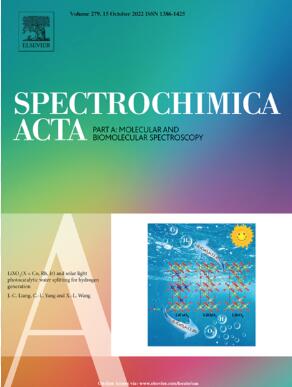Dual-functional carboxymethyl chitosan-coated silver nanoparticles for bacterial detection integrated with spectral processing and sterilization
IF 4.3
2区 化学
Q1 SPECTROSCOPY
Spectrochimica Acta Part A: Molecular and Biomolecular Spectroscopy
Pub Date : 2025-04-03
DOI:10.1016/j.saa.2025.126171
引用次数: 0
Abstract
The development of a dual-functional nanomaterial integrating microbial detection and sterilization capabilities are of great significance for advancing food safety applications. In this work, we synthesized carboxymethyl chitosan coated with spherical silver nanoparticles (CMCS@Ag NPs). CMCS@Ag NPs exhibited improved stability of surface-enhanced Raman scattering (SERS) signals compared to single silver nanoparticles in the detection of three strains including E. coli, S. aureus and S. putrefaciens. Through deuterium isotope labelling, metabolically active bacterial cells produced characteristic carbon-deuterium (C–D) vibrational signatures detectable by Raman spectroscopy. The spectral overlap between C-D and C–H stretching modes showed concentration-dependent linear responses, achieving a detection sensitivity of 0.64 CFU/mL for E. coli. Meanwhile, different combinations of algorithm were used to pretreatment with the raw Raman spectra, among that adaptive iterative reweighting punishment least square method and moving average smoothing (air-PLS + MAS) sensitively obtain better preprocessing accuracy of the three strains. Principal component analysis (PCA) was used to extract characteristic peaks from pretreatment spectra to successfully discriminate the three microorganisms. Furthermore, CMCS@Ag NPs incubated with phosphate-buffered saline (pH ∼ 5.8) exhibited potent antibacterial activity, achieving 99 % reduction in viability for E. coli, S. aureus and S. putrefaciens at a concentration of CFU/mL within 45 min. This work presents a versatile nanomaterial-based strategy for simultaneous pathogen detection and inhibition.

求助全文
约1分钟内获得全文
求助全文
来源期刊
CiteScore
8.40
自引率
11.40%
发文量
1364
审稿时长
40 days
期刊介绍:
Spectrochimica Acta, Part A: Molecular and Biomolecular Spectroscopy (SAA) is an interdisciplinary journal which spans from basic to applied aspects of optical spectroscopy in chemistry, medicine, biology, and materials science.
The journal publishes original scientific papers that feature high-quality spectroscopic data and analysis. From the broad range of optical spectroscopies, the emphasis is on electronic, vibrational or rotational spectra of molecules, rather than on spectroscopy based on magnetic moments.
Criteria for publication in SAA are novelty, uniqueness, and outstanding quality. Routine applications of spectroscopic techniques and computational methods are not appropriate.
Topics of particular interest of Spectrochimica Acta Part A include, but are not limited to:
Spectroscopy and dynamics of bioanalytical, biomedical, environmental, and atmospheric sciences,
Novel experimental techniques or instrumentation for molecular spectroscopy,
Novel theoretical and computational methods,
Novel applications in photochemistry and photobiology,
Novel interpretational approaches as well as advances in data analysis based on electronic or vibrational spectroscopy.

 求助内容:
求助内容: 应助结果提醒方式:
应助结果提醒方式:


